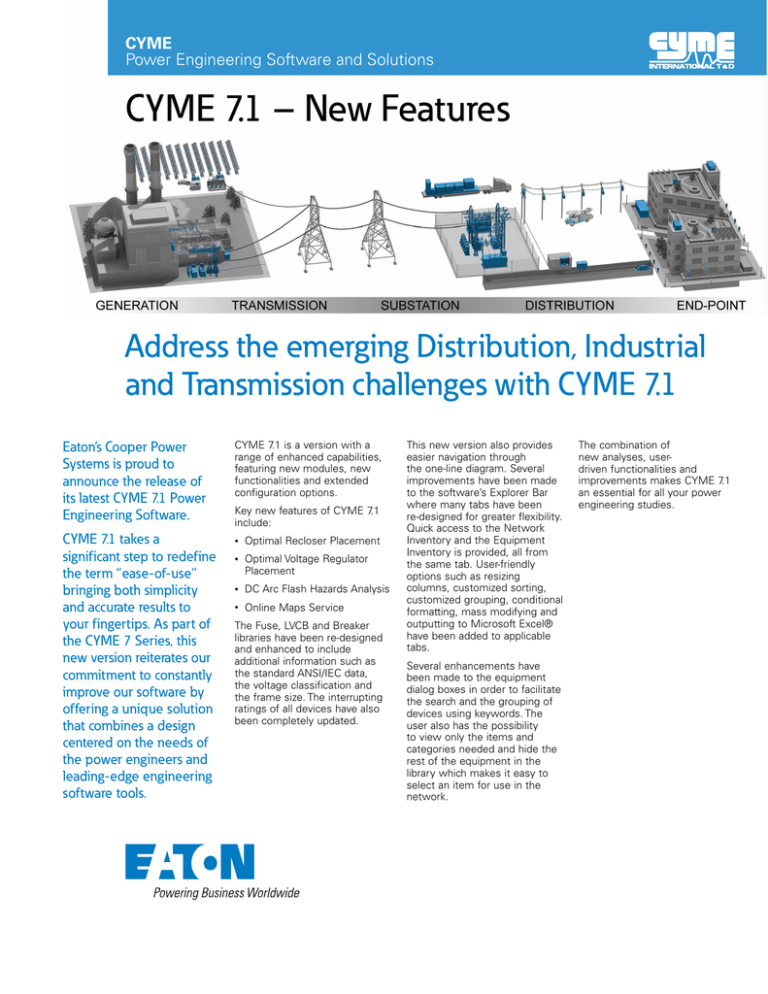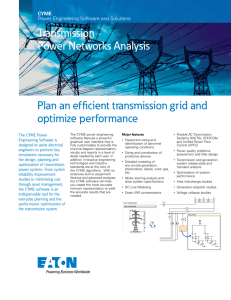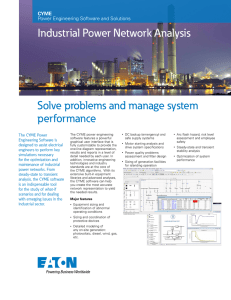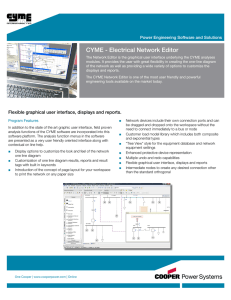
CYME
Power Engineering Software and Solutions
CYME 7.1 – New Features
Address the emerging Distribution, Industrial
and Transmission challenges with CYME 7.1
Eaton’s Cooper Power
Systems is proud to
announce the release of
its latest CYME 7.1 Power
Engineering Software.
CYME 7.1 takes a
significant step to redefine
the term “ease-of-use”
bringing both simplicity
and accurate results to
your fingertips. As part of
the CYME 7 Series, this
new version reiterates our
commitment to constantly
improve our software by
offering a unique solution
that combines a design
centered on the needs of
the power engineers and
leading-edge engineering
software tools.
CYME 7.1 is a version with a
range of enhanced capabilities,
featuring new modules, new
functionalities and extended
configuration options.
Key new features of CYME 7.1
include:
•
Optimal Recloser Placement
•
Optimal Voltage Regulator
Placement
•
DC Arc Flash Hazards Analysis
•
Online Maps Service
The Fuse, LVCB and Breaker
libraries have been re-designed
and enhanced to include
additional information such as
the standard ANSI/IEC data,
the voltage classification and
the frame size. The interrupting
ratings of all devices have also
been completely updated.
This new version also provides
easier navigation through
the one-line diagram. Several
improvements have been made
to the software’s Explorer Bar
where many tabs have been
re-designed for greater flexibility.
Quick access to the Network
Inventory and the Equipment
Inventory is provided, all from
the same tab. User-friendly
options such as resizing
columns, customized sorting,
customized grouping, conditional
formatting, mass modifying and
outputting to Microsoft Excel®
have been added to applicable
tabs.
Several enhancements have
been made to the equipment
dialog boxes in order to facilitate
the search and the grouping of
devices using keywords. The
user also has the possibility
to view only the items and
categories needed and hide the
rest of the equipment in the
library which makes it easy to
select an item for use in the
network.
The combination of
new analyses, userdriven functionalities and
improvements makes CYME 7.1
an essential for all your power
engineering studies.
Optimal Recloser Placement
Analysis
Optimal Voltage Regulator
Placement Analysis
Installing reclosers in optimal
locations to improve reliability
can be challenging. The new
CYME 7.1 Optimal Recloser
Placement analysis module
determines the optimal location
of the network to install the
reclosers. The assessment
is based on reliability indices
calculated from the Reliability
Assessment module.
The new CYME Optimal Voltage
Regulator Placement analysis
module recommends optimal
locations for voltage regulators
on a distribution network with
one or multiple feeders.
The analysis uses one or the
combination of the following
objectives based on the weight
of their importance:
•
Improve SAIDI (System
Average Interruption Duration
Index)
Optimization is achieved using
one or a combination of the
following objectives:
•
Flatten voltage profile at
specified target voltage
•
Minimize active power losses
With the Optimal Voltage
Regulator Placement module
one can:
DC Arc Flash Hazards Analysis
Online Maps Service
We introduce with CYME 7.1
a new DC Arc Flash Hazards
module that computes DC arc
flash parameters for any DC
Node on your DC Network. The
analysis uses the DC ShortCircuit Analysis module.
The CYME Online Maps Service
is a new service that brings
Google and MapQuest Open
maps as background maps for
your CYME network.
The DC Arc Flash analysis
supports three methods which
are covered in the industryrecognized NFPA-70E©
standard:
•
Stokes & Oppenlander
•
Paukert
•
Maximum Power
Install multiple regulators at
once
•
•
Select sequential/iterative
search
Arc flash hazards color coding
for one-line diagram
•
Improve user-defined criteria
based on CYME Keywords
•
Search and place regulators on
user-defined locations
Batch mode simulation, that
performs the analysis on every
bus in the network in one
single simulation
The Optimal Recloser Placement
simulation features:
•
Display the optimal or all
possible solutions in tabular
reports
•
Automatic detection and
validation of protection
schemes in the DC network
•
Generate initial and final
voltage profile charts
•
•
View load flow reports
Calculation using default
values depicted by standards,
or using user-specified values
•
•
Improve SAIFI (System
Average Interruption
Frequency Index)
Installation of multiple
reclosers at once
•
Sequential/Iterative search
•
Search for optimal locations
and placement of reclosers on
user-defined locations
•
•
•
Tabular reports
•
A chart tool allowing
comparison between
different arc energy scenarios
depending on clearing time
and working distance
Display of the optimal or all
possible solutions in tabular
reports
Access to Reliability
Assessment analysis reports
and keywords
•
Access to the online providers’
background maps through the
Background Map tab in the
Explorer bar and through a
new “Map” toolbar.
•
Location search using address,
X-Y Coordinates or GPS
Coordinates in the Google or
MapQuest background maps
The analysis features:
•
•
The Online Maps Service comes
with options such as:
•
Custom warning labels to
display information such as
arc flash boundary, incident
energy at working distance,
risk category and personal
protective equipment
Google map view of Galveston Island
Google and the Google logo are registered
trademarks of Google Inc., used with
permission.
Geographic Overlay
Multiple improvements have
been made to the Geographic
overlay module making it an
even more useful tool.
•
More than 3000 coordinate
systems available
•
Coordinate system selection
assistant
•
Coordinates can be displayed
in decimal degrees or in
degrees-minutes-seconds
•
X-Y, longitude and latitude
coordinates now shown in the
node properties dialog box.
•
New Map toolbar
•
Display .kml and .kmz files in
CYME.
Equipment Rating Verification
Analysis
The new Equipment Rating
Verification analysis is designed
to help ensure that protection
devices and cables can
withstand fault currents as
per ANSI or IEC requirements
and that protective devices
do not trip during steady-state
conditions.
The analysis:
•
Evaluates the fault currents
throughout the network and
generates a warning report if
any of the device interrupting
ratings as specified in the
equipment database is
exceeded.
•
Verifies for any device
overload and bus voltage
violations.
•
Provides tabular reports for
abnormal conditions by device
type, fault level, interrupting
rating, the current violation in
percent
•
Cable Modeling
In CYME 7.1, the Cable
Equipment Library has been
improved with additional data
fields for construction details.
To complete the enhancement,
the section properties dialog
boxes of CYME 7.1 have been
redesigned to allow the detailed
modeling of any cable in your
networks.
Two new libraries complement
the Cable Equipment Library.
The Conductor Material Library
contains the electrical resistivity
and temperature coefficient of
various conductor materials.
The Insulation Material Library
has been added to specify
the dielectric constant and
temperature limits of various
insulation materials. Additional
user-defined conductor and
insulation materials can also be
specified.
Protective Device Analysis
•
Multiple display view
•
View naming pattern
•
View renaming option
•
Phase and / or Ground
protection combo box
•
Phase and / or Ground curve
selection
The TCC Toolbar is more
complete with the addition of
the margin anchor, test point,
add circle, add line and add text
options.
The TCC title block now has
the option of adding up to two
company logos in the TCC title
block using the grid options.
CYME 7.1 brings numerous
enhancements and new features
to the CYME Scripting Tool with
Python:
•
The CYME Scripting Tool
with Python is now included
with the CYME software
installation.
•
You can select your preferred
version of the Python
installation (interpreter, editor
and debugger) to use within
the CYME software.
•
You can now benefit from:
•
Provides one-line diagram
color coding layer
CYME 7.1 extends the Protective
Device Analysis module
capabilities by adding new View
Options such as:
CYME Scripting Tool with
Python®
•
More accurate cable
impedance calculations as
a result of improved cable
modeling through the new
data fields added in the cable
equipment library and the
cables settings.
Possibility to define cable
construction details directly in
the Conductor and Insulation
Material Libraries. Separate
conductor equipment
modeling is no longer needed.
New analyses are accessible
through the scripting tool such
as:
• Optimal Capacitor
Placement
• Fault Locator
• Equipment Rating
Verification
• Minimum Fault
• Dynamic Motor Start
• Locked Rotor
• Maximum Start Size
• Arc Flash Hazards
• DC Arc Flash Hazards
• Steady State Analysis with
Load Profiles
• Optimal Power Flow
• Reliability Assessment
•
Python script samples are
now provided within the
Python Toolbox.
•
Possibility to model the cable
by layers and to specify the
details of each layer in the
same dialog box. Armored
cables can now be modeled.
•
The Python tools, including
the Python Toolbox and the
Python Console, have been
completely revised and
redesigned.
•
New option to model threecore TECK cables with neutral.
•
New Python toolbar
•
Python Editor – a new
complete built-in script editor
that focuses on simplicity and
ease of use. Its features, to
name a few, include:
• Color-coding
• Code completion
• Debug mode
• Line numbers display
• Syntax highlighting
• Program runner
• Printing
• Word searching
• Word replacement
Python® Embedded Scripts
In addition to the automation
possibilities already available in
the Python Toolbox, CYME 7.1
offers a series of new scripting
functionalities embedded in
several device controls and
customization tools outside
of the CYME Scripting Tool
with Python module. With
user-defined scripts you can
significantly customize the
capabilities of the software:
•
Embedded Python scripting
can now be used for:
• Capacitor control (threephase)
• Capacitor control (singlephase)
• Centralized capacitor control
system
• Regulator control (threephase)
• Regulator control (singlephase)
•
Custom keywords - It is
possible to create a keyword
using an expression with a
Python Script.
•
Custom filters - You can now
use a Python Script when
creating a new filter.
CYME 7.1
New Features
Address the emerging
Distribution, Industrial and
Transmission challenges
with CYME 7.1.
Batch Analysis
Run several user-defined
scenarios on a selection of
studies, self-contained files
and multiple networks available
in the database with the new
CYME 7.1 Batch Analysis.
Benefit from the flexibility
of creating several analysis
scenarios and for each scenario
choose as many analyses as
listed below:
•
Arc Flash Hazards
•
Equipment Rating Verification
•
Load Flow
•
Minimum Fault
•
Protection
•
Reliability
•
Short-circuit
The analysis scenarios are
entirely configurable. A typical
analysis scenario can include
several analysis simulations for
which you can specify different
study parameters for each
execution if you wish or global
study parameters for each
simulation.
For one execution of the Batch
Analysis you can generate
detailed reports and summary
reports for multiple analyses.
To maximize your results, the
Batch Analysis can also be
coupled with the Advanced
Project Manager module and the
Automated Network Forecast
Analysis module to run the
Batch Analysis Scenario on userdefined project scenarios or subprojects.
Eaton
1000 Eaton Boulevard
Cleveland, OH 44122
United States
Eaton.com
CYME International T&D
1485 Roberval, Suite 104
St.Bruno, QC, Canada J3V 3P8
P: 450.461.3655
F: 450.461.0966
P: 800.361.3627 (Canada/USA)
CymeInfo@eaton.com
www.cyme.com
© 2014 Eaton
All Rights Reserved
Printed in Canada
Publ. No. BR 917 043 EN · November 2014
Low-Voltage Distribution
Network Modeling and
Analysis
With CYME 7.1, the Low-Voltage
Distribution Network Modeling
and Analysis module is even
more powerful and complete
with the addition of new device
models for:
•
Center-tap connected sources
•
Center-tap connected meters
This allows you to specify a
center-tap demand. A precise
load allocation analysis is now
possible on a low voltage
network given the center-tap
demand.
Harmonic Analysis
New features in the Harmonic
Analysis module include:
•
An option within the source
model to add user-defined
background harmonic voltage
to the source harmonic
envelope.
•
Two new harmonic load
models Parallel R-L (with skin
effect) and Series R-L (without
skin effect).
•
A new filter sizing report
which provides harmonic
and fundamental resistor
losses, fundamental and
harmonic current through the
reactance and fundamental
and harmonic voltages across
the capacitor to help you size
your filter.
•
The addition of transformer
K-Factor (ANSI/IEEE) and
Factor-K (BSI) calculation to
the harmonic analysis. These
factors are necessary to
evaluate the nominal rating
of transformers serving
non-linear loads. Increasing
harmonic load currents have
a direct effect on transformer
overheating and transformer
losses (Eddy losses). The
higher the K-Factor/Factor-K
the greater the harmonic
heating effects. Two methods
are used:
• ANSI/IEEE C57.110™
where the K-Factor can be
used to select the proper
transformer (K-Factor of
1, 4, 9, 13, 20, 30, 40 or
50) without de-rating the
nominal rating.
• European Standard EN
50464-3:2007 where the
Factor-K represents a
transformer de-rating factor
to prevent overloads due to
non-linear loads.
Detailed center tap connected
load connections for spot and
distributed loads can now be
specified:
•
Phase (1-N)
•
Phase (2-N)
•
Phase (1-2)
Secondary Grid Network
Analysis
A new robust load flow method
tailored to solve heavily meshed
unbalanced secondary grid
networks is now available in the
load flow analysis dialog box.
You can now select the NewtonRaphson Unbalanced calculation
to perform a load flow on your
secondary grid network.
Eaton, Cooper Power Systems and CYME are
valuable trademarks of Eaton in the U.S. and
other countries. You are not permitted to use
these trademarks without the prior written
consent of Eaton.
© 2012 Google Inc. All rights reserved. Google
and the Google logo are registered trademarks
of Google Inc.
© 1996-2002 MapQuest.com, Inc. All rights
reserved. MapQuest is a trademark of
MapQuest.com, Inc.
All other trademarks are property
of their respective owners.










